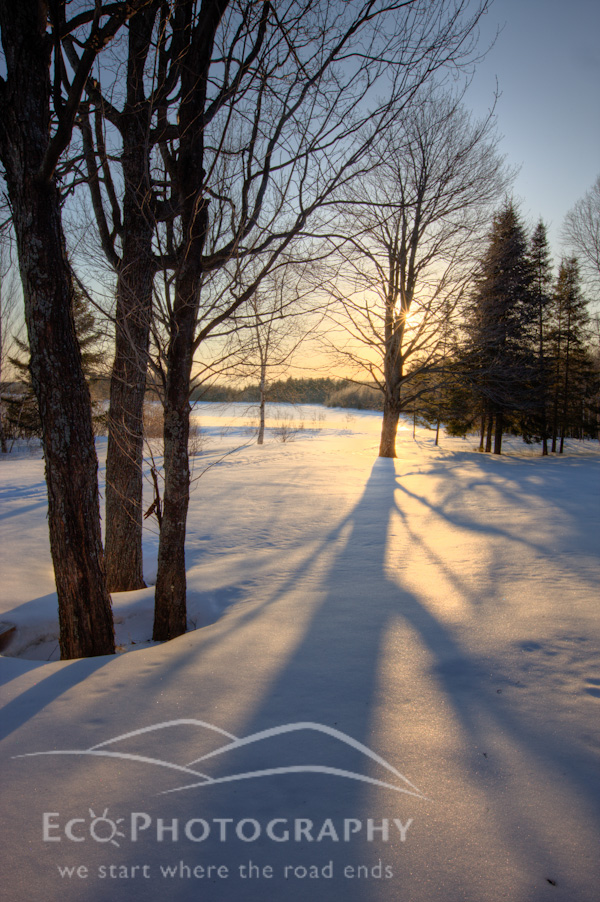
Winter Photography Time! Enjoying winter’s magic in Portsmouth, New Hampshire.
It is almost time to enjoy winter’s magic and winter photography. As a kid I craved snow days, not for the break from school, but for the excitement of playing in a yard full of material you could dig in, sculpt, eat, build with, and throw at your friends (and passing cars…) Thankfully I still have that joyous view of winter storms, which is a good thing since I live in a place where it snows a good five months a year. I love winter hiking, skiing, and of course winter photography, so with our New Hampshire landscape currently a dull gray and brown, I am rooting for a good dumping of the white stuff to come as soon as possible. I mean, I’ve got plenty of work I can do here in my studio, but I’d much rather be out shooting and playing. Last week I gave a lecture to the South Shore Camera Club in Quincy, MA, that I call “Light and the Winter Landscape,” where I try to inspire those who put their cameras away for the winter to put on some layers and get out there shooting when the snow and ice appear. I’ll outline a few of the tips from that lecture here.

Man winter hiking. Rime ice covers the rocks and a trail sign on Mount Washington in New Hampshire’s White Mountains.
First, learn how to keep you and your gear in working order. Winter is not fun if you are cold, wet, and miserable, but it doesn’t have to be that way. Dress in layers, starting with a thin wickable layer of polypro or silk long underwear (socks, underwear, pants, shirt, and gloves.) Add an insulating layer of fleece or wool and then a waterproof and windproof (and preferably breathable) top layer. This is the perfect combination of clothes if you are actively hiking or skiing. When you inevitably warm up from the exertion, take off a layer to prevent perspiration from getting trapped in your clothes and cooling you down. You’ll notice I didn’t say to wear cotton clothing – it’s a killer in the winter as it soaks up sweat, stays wet, and can quickly chill you. I’ll add a layer when I stop to shoot to stay warm. If I’m driving around and shooting, and thus not exercising much, I’ll wear a big down parka as my outer layer. And of course, wear a hat or balaclava to keep you even warmer. On my hands I’ll wear a pair of gore-tex overmitts and wool mittens when I’m not shooting, and strip down to my polypro glove liners when I need to access my cameras controls. I’ll also sometimes wear wool mittens that have the a detachable mitten part that I can peel back to reveal fingerless gloves. On my feet, I really love wearing my Sorrel double boots which have a leather/rubber outer boot with a removable felt liner. They keep my feet warm and comfy down to 20 below without even exercising. One last thing, don’t forget to eat and drink on a regular basis. You burn a lot of calories in the winter and you need to keep adding fuel to your system to generate body heat.

Maple tree silhouette. Hadley, Massachusetts.
As far as my camera gear is concerned, I pay attention to two important problems that occur when shooting in winter conditions – power and moisture. Cold temperatures sap battery power quickly. The lithium batteries that come with most DSLR’s do better than alkaline batteries, but they’ll still drain on you faster than in warm weather. I always keep two fully-charged spares with me on a winter shoot, keeping them in a pocket that is close to my body to keep them warm. I also use my LCD and autofocus a lot less than I usually do as these features are real power hogs. I’ve never had any problem with my Canon DSLRs in shooting conditions down to 20 below (Fahrenheit). I’ve never had to shoot in colder conditions. Moisture is a bigger concern. Obviously, snow is everywhere and snow turns to water when it gets warm, so I’ll shoot with a nylon camera cover if it is snowing out and use a Giotto rocket blower to blow snow off my camera when it does get some flakes on it, which is a better solution than wiping it with your gloves as the warmth from your hand will melt the snow and cause your camera to get wet. Just as important is to NOT bring your camera from the cold directly into a warm place, whether it is inside a building or inside your jacket. The warm, moist air of these places will instantly condense on your camera and even inside your lens, fogging it to the point of being useless for hours and potentially damaging it permanently. When you bring your gear inside, either place it into plastic ziploc bags or zip it tightly into your camera bag and leave it there until it warms to room temperature, which can sometimes take a few hours. I once mistakenly brought a lens inside on a cold day and had to bake it in the oven at 150 for 45 minutes to burn off the fog – I don’t recommend this!

Trees, snow, and shadows at Medawisla Wilderness Camps near Greenville, Maine. Winter.
Once you learn to take care of your body and gear, winter photography is a real blast and in some ways easier than shooting at other times of the year. The sun comes up later in the morning, so there’s no need to get up at 4:00 a.m. All that snow simplifies the landscape making composition an easier task. Winter skies are clearer, creating a cleaner light that really sparkles with the snow. And the snow reflects all the color in that light, which can make for dramatic photos. Keep in mind that snow in your shadows will reflect the opposite color of your highlights. So in warm, yellow sunrise light, your shadows will be blue. In even warmer, orange sunrise light, your shadows will tend towards purple. Also think about the texture of your snow – diffuse, overcast light softens the look of snow, while direct sunlight will reveal more texture and individual snow crystals, especially when you are using sidelighting or backlighting. As for exposure, you’ll usually need to open up 1 1/2 to 2 stops (making a brighter exposure) from what your meter says if you are metering on snow. If you’re unsure about your exposure, check your histogram and make sure you are exposing your image so that the histogram extends all the way over to the right edge of the graph.
Other than that, the techniques for making good winter photographs are the same as any other time of year. Of course, none of this matters if you don’t get outside, play and shoot.
Until next time…
-Jerry






Pingback: Tweets that mention Winter is Coming – Get out the Camera! – Jerry & Marcy Monkman -- Topsy.com
Those are some excellent cold-weather tips.
I do a lot of winter shooting, more often than not looking for Snowy Owls in Salisbury and Plum Island – not too far from you.
One tip I have to share – and you alluded to it – is that I don’t want to thermally shock my gear by going from a warm car to a cold outdoors.
I drive about 75 miles from my home in Scituate, MA to get where I’m owl hunting. I never warm the car up much, but at about 20 minutes away, I have inched the heat down gradually to the point where it’s completely off. At about 5 minutes out, I have the windows cracked open.
Doing this ensures that the big glass (I shoot with the Canon 600 mm f4 L IS) isn’t going through lots of expansion or contraction – or getting fogged.
Have fun shooting this winter!
Charlie MacPherson
http://www.TheAmazingImage.com
Thanks for the additional tip Charlie. I usually keep the car cold as well so I don’t sweat too much in all my winter gear so I’m not damp when I step out into the cold. Good luck with the owls this year!
Great post with some sage advice. I also enjoyed the shot of the hiker. Very cool
Hi, I love the photos. Its been snowing here in the uk all week so seeing the pictures have given me some inspiration. Thanks.
I cannot agree with this post more. Winter is a great and exciting time of year to get out and shoot. Being out in the snow seems to have an almost mythical sort of quality about it.
I have also had that problems with condensation before on a rainy day, where I got condensation on the inside of one of one of my lenses and it was not fun. I was glad I at least had a 50mm, but I still couldn’t get the wide shoots I wanted on that day.